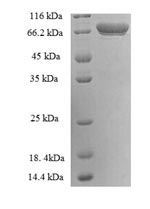Generating recombinant human protein-glutamine gamma-glutamyltransferase 2 (TGM2) involves isolating the target gene coding for the human TGM2 (4-544aa). This gene is fused with an N-terminal 6xHis-SUMO-tag gene and then cloned into an appropriate expression vector. The vector is transformed into E. coli cells, which are induced to express the recombinant TGM2 protein. These cells are lysed to release the recombinant TGM2 protein. Purification of the collected TGM2 protein is typically achieved using affinity chromatography. Its purity is over 90% as determined by SDS-PAGE.
Human TGM2 is a member of the transglutaminase enzyme family, catalyzing the post-translational modification of proteins by forming isopeptide bonds [1]. TGM2 is a calcium-dependent enzyme that incorporates lysine residues or polyamines into protein-bound glutamine residues, facilitating protein cross-linking modifications [2]. TGM2 can serotonylate histone H3 tri-methylated lysine 4, enhancing TFIID binding to nucleosomes [3]. TGM2 is upregulated in various types of cancer, contributing to tumor-promoting inflammation [2]. It is involved in cellular processes such as apoptosis, being a major target of glutamine in apoptotic signaling [4].
Research has shown TGM2's role in various diseases and conditions. In heart failure, TGM2 has been studied in the context of circulating proteomics, providing insights into related programs [5]. TGM2 is associated with reprogramming transcription regulatory networks in epithelial cells through the constitutive activation of NF-κB, indicating its involvement in inflammatory responses [6]. TGM2 is significantly upregulated in cystic fibrosis, suggesting a potential role in the disease's pathophysiology [7].
References:
[1] M. Griffin, R. Casadio, & C. Bergamini, Transglutaminases: nature’s biological glues, Biochemical Journal, vol. 368, no. 2, p. 377-396, 2002. https://doi.org/10.1042/bj20021234
[2] S. Cho, Y. Oh, E. Jeong, S. Park, D. Lee, X. Wanget al., Amplification of transglutaminase 2 enhances tumor-promoting inflammation in gastric cancers, Experimental & Molecular Medicine, vol. 52, no. 5, p. 854-864, 2020. https://doi.org/10.1038/s12276-020-0444-7
[3] L. Farrelly, R. Thompson, S. Zhao, A. Lepack, Y. Lyu, N. Bhanuet al., Histone serotonylation is a permissive modification that enhances tfiid binding to h3k4me3, Nature, vol. 567, no. 7749, p. 535-539, 2019. https://doi.org/10.1038/s41586-019-1024-7
[4] K. Thomas, L. Zondler, N. Ludwig, M. Kardell, C. Lüneburg, K. Henkeet al., Glutamine prevents acute kidney injury by modulating oxidative stress and apoptosis in tubular epithelial cells, Jci Insight, vol. 7, no. 21, 2022. https://doi.org/10.1172/jci.insight.163161
[5] F. Zannad, J. Ferreira, J. Butler, G. Filippatos, J. Januzzi, M. Suminet al., Effect of empagliflozin on circulating proteomics in heart failure: mechanistic insights into the emperor programme, European Heart Journal, vol. 43, no. 48, p. 4991-5002, 2022. https://doi.org/10.1093/eurheartj/ehac495
[6] S. Kumar and K. Mehta, Tissue transglutaminase constitutively activates hif-1α promoter and nuclear factor-κb via a non-canonical pathway, Plos One, vol. 7, no. 11, p. e49321, 2012. https://doi.org/10.1371/journal.pone.0049321
[7] N. Rauniyar, V. Gupta, W. Balch, & J. Yates, Quantitative proteomic profiling reveals differentially regulated proteins in cystic fibrosis cells, Journal of Proteome Research, vol. 13, no. 11, p. 4668-4675, 2014. https://doi.org/10.1021/pr500370g






